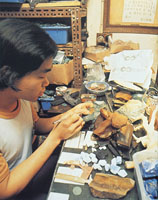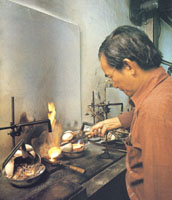| Jewellery
Hong Kong's jewelry industry
mainly consists of two sectors, namely imitation (costume)
jewelry and precious jewelry. The latter includes
gold ornament, jade, pearl, precious stone and gem-setting.
The jewellery industry is a
labour-intensive industry. Work processes, such as
smelting, mould making, welding, gem-setting are mostly
manual operations. However, Casting, pre-polishing,
engraving and electroplating have been automated with
the use of wax casting facilities, polishers, electroplating
equipment and electric furnace. A number of larger
establishments have made use of sophisticated and
computerized equipment such as vacuum casting machines,
computer-aided design and manufacturing (CAD/CAM)
systems, as well as computer numerically controlled
(CNC) machine tools, so as to achieve massive production
and enhance design ability.
Combined with re-exports, Hong
Kong is the fourth largest exporter of precious jewelry
behind Italy, Switzerland and the UK. Domestic exports
of jewelry stood at HK$4,789 million in 1999, churned
out by 911 establishments with a total of 6,177 workers.
 |
|
 |
| Surrounded by an assortment of semi-precious
gemstones, a craftsman preparing the components
for a necklace outlines a shape on a piece of
malachite. |
|
Hong Kong designers have won an international
reputation for their creative designs and their
ability to work with a variety of precious and
semi-precious materials. |
|
|

A goldsmith
is carefully pouring melted gold into a mould to form
a 5-tael gold block.

A technician
is engraving a piece of rose quartz.

Cutting jade
correctly is a skilled art.
|



